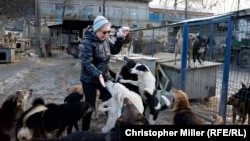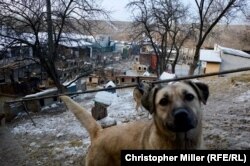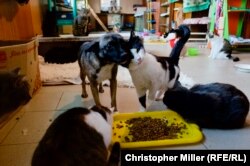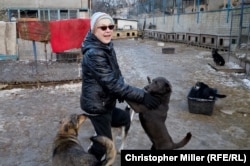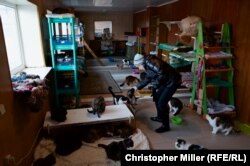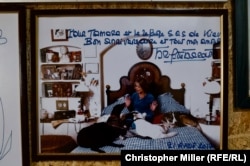PYROHIV, Ukraine -- When Tamara Tarnavska peered through a hole in the fence surrounding a mysterious compound in this quiet neighborhood on the southern outskirts of Kyiv, what she saw horrified her.
Dogs and cats -- hundreds of them -- were being rounded up and killed in such "brutal" ways that Tarnavska says she doesn't want to describe the disturbing scene again.
It was a "killing factory," Tarnavska says, where "animal hunters" had for decades taken strays to be "liquidated."
After she published a documentary film made using a hidden camera that exposed those activities (editor's note: Tarnavska worked for RFE/RL's Ukrainian Service at the time) Kyiv authorities shut the facility down and made the journalist-cum-activist an offer: she could lease the land free-of-charge for 49 years if she turned it into a sanctuary for strays.
That was 1997.
More than 21 years later, Tarnavska, a Kyiv-born Norwegian who says she's loved animals since she was a child, still heads the SOS International Animal Protection Society, an animal-rights group in the Ukrainian capital.
"I promised to close this place and build the shelter and stay with animals and protect them," she says of what became Ukraine's first such animal shelter.
Since then, she estimates she's saved more than 20,000 dogs and cats from the streets and the clutches of their would-be killers. All of them have been spayed or neutered in an attempt to help Ukraine get its stray-animal problem under control.
Ukraine has long struggled with what to do with its strays. City programs aimed at sterilization and the creation of animal shelters have been introduced in the past, but they are rarely implemented in full and the funds for such programs often disappear.
In lieu of government programs, "animal hunters" have sometimes taken matters into their own hands.
In the run-up to the Euro 2012 soccer championship that Ukraine co-hosted, thousands of stray dogs were reportedly killed -- often with poison-laced meat or injections of illegal substances -- in an effort to clear the streets of host cities before the big tournament kicked off that June.
Some residents at the time openly admitted to shooting and otherwise killing stray dogs with impunity.
Such slaughters continued through 2013, reportedly targeting strays in Kyiv in the name of public health.
There were more reports of the same ahead of the 2017 Eurovision Song Contest. And while some claimed those reports were false, Tarnavska says her organization was aware of "thousands" of animals being killed, often with poisons that caused them to fall over, froth at the mouth, and shake violently until they died.
"Ukrainian authorities look at stray animals like they're rubbish," Tarnavska says.
At Tarnavska's shelter on a recent, snowy November day, she is housing 328 cats and more than 1,000 dogs that have been saved from such a fate. There is plenty of barking and tail-wagging, but no biting.
Among them are more than 200 animals saved by Ukrainian soldiers from the war zone in the eastern Donetsk and Luhansk regions after their owners left them behind when they fled.
One such dog is named Cyborg, after the nickname given to Ukrainian soldiers who fought Russia-backed separatists for control of the strategic Donetsk airport for 242 grueling days. Cyborg has been slow to open up, and is kept in a pen most of the time. But like the hundreds of other dogs and cats there, he is safe and well-fed.
A small group of volunteers and donations from Ukrainians and Western Europeans help keep them that way.
Volunteers deliver scraps of meat from supermarkets around Kyiv in a van donated to the shelter. Adorning its side are the words, in English, "Everyone should have a house."
Hanging on the walls of a small office on the shelter property are news clippings and photographs of Tarnavska alongside former Ukrainian presidents and Western ambassadors.
And there are letters from French film luminary and animal-rights advocate Brigitte Bardot, this shelter's first donor who continues to support it through her own foundation.
While the shelter still exists rent-free, taking care of the animals requires a lot of help, time, food, and money. Those costs rise especially in winter, when temperatures are almost continuously below freezing and electricity bills are high.
Now Tarnavska faces yet another challenge. Animal hunters and other heavies whom she claims have been hired by politicians who want to see the land developed are visiting the shelter with greater regularity and harassing her and the animals.
In at least one instance, she says, men showed up with guns and began shooting at the dogs. RFE/RL could not independently corroborate her claim, but it aligns with previous reports.
Other times, Tarnavska’s cars have been torched, and groups of men have shown up and threatened her, even blocking her vehicle and preventing her from leaving the compound.
Tarnavska says she's asked local police to investigate, but so far there has been no response. She speculates that it's because so many people are either indifferent toward the animals or want them gone.
"People don't understand why I'm helping animals, because it doesn't make me money," she says.




